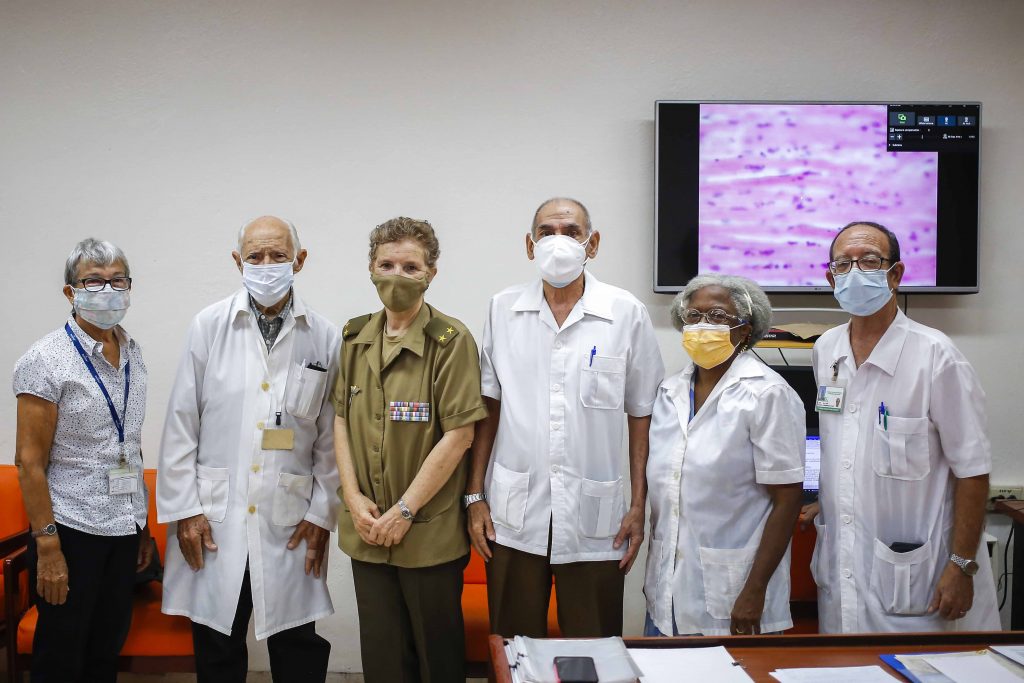
HAVANA, Cuba, Aug 30 (ACN) Understanding in its full dimension how COVID-19 behaves and how much damage it can cause to a person is essential to establish the best treatment, both in the clinical stage and during convalescence.
In this aspiration, it is vital to take a close look at the disease and relate each step of its evolution, mainly when patients die, to determine to what extent the virus spread through the organism, how far the lesions reached and what their response was.
Behind that keen look is a team of experts in pathological anatomy that every Tuesday and Thursday, since April 2020, meets at the Clinical Surgical Hospital "Hermanos Ameijeiras", in Havana, to analyze the autopsies of the deceased by COVID-19 that arrive from different centers of the country and, based on the joint criteria, establish a more qualified diagnosis from the scientific point of view.
"The work of the autopsies has been like going through a postgraduate course because we are rediscovering many things about this disease and the contribution has been very important", commented Lieutenant Colonel Teresita Montero Gonzalez, head of the Development Center of the Naval Hospital, since the outbreak of the phenomenon, with only a few hours of rest and only one day off every two weeks.
Jose Hurtado de Mendoza Amat, II Degree Specialist in Anatomic Pathology and Associate Professor and Consultant at the same hospital, explained that the damage produced by COVID-19 is similar to that observed in other diseases associated with systemic inflammatory response, but the severity of the lesions in this case is much greater.
Although studies continue, experts have been able to determine some partial results that have been published in international journals.
What is the evidence obtained?
From the sampling of some tissues, lesions in the lung have been shown to be the most frequent and significant ones -major complications and lethality-, although the whole organism is affected as damage is also found in the kidney, heart, brain and the digestive system in general.
COVID-19 is no longer referred to as a respiratory disease but as a vascular disease, because the pathogen receptors are present not only in the respiratory tract, but also in epithelial and endothelial cells, which explains why several organs suffer some type of deterioration.
Some of those analyzed had sicklemic features that were not known during their lifetime and appeared after the post-mortem examination, which becomes a complication of COVID-19 in the face of one of the characteristics of the disease: hypoxia or oxygen demand.
Internationally, this phenomenon is described as a "happy anoxia", that is, people have shortness of breath but do not give it any importance and get late to receive specialized care, sometimes they mistake the condition for a cold and can complicate their condition and affect their family.
On the other hand, this coronavirus has a great impact on the kidneys, even without apparent lesions, since practically all the cases analyzed have some type of renal damage. In particular, chronic kidney disease has been a life-threatening comorbidity in many patients.
The young people who died from the virus generally had comorbidities, were diabetic or hypertensive and did not know it, conditions associated with morphological disorders such as obesity, overweight or extreme thinness.
As for pregnant women, the inflammatory response triggered by COVID-19 poses a greater risk, because pregnant women usually suffer from inflammation in the second trimester of gestation, which is aggravated by the inflammation generated by the virus, in addition to the fact that many of them do not go to the doctor immediately when the symptoms begin.
When the systemic inflammatory response goes out of control, immune dysfunction occurs and the consequent storm of mediators that results in multi-organ damage, present in 70.3 % of the autopsies reviewed, where COVID-19 was the basic cause of death.
Many of them, with negative PCR test, show indisputable alterations caused by the virus in their lungs and compromising all their morphological structures.
After-effects: a future problem
As the aggressiveness of SARS-CoV-2 increases due to the presence of genetic variants with greater pathogenicity and multiorgan lesions are more severe, it is expected that patients' convalescence will also worsen and other diseases will be more frequent in the future.
In the country, around 90 % of those infected have recovered from the disease; however, experts point out that it is necessary to be prepared for the complications that may remain.
Based on the metaplastic and atypical transformations found in several cases studied, the damage could lead to cancer or Guillain-Barre syndrome, which has also accompanied other viral diseases; there could also be renal, hepatic and cerebral lesions related to the coronavirus.
Likewise, there are lesions that are not yet known and are currently being investigated, as well as there are people who will never develop the expected amount of antibodies against the pathogen, among them, the elderly, who due to their immunosenescence have a low immune system.
The transmission of COVID-19 has a strong social component, hence the importance of maintaining care, even after vaccination and especially in households where the elderly, children or pregnant women live.
Continuing with the correct use of the sanitary mask, complying with hygienic and distancing measures and ensuring the ventilation of spaces are currently the best ways to protect ourselves as immunization progresses in the country, which will prevent a greater number of people from becoming seriously ill and dying.










Nos reservamos el derecho de no publicar los comentario que incumplan con las normas de este sitio